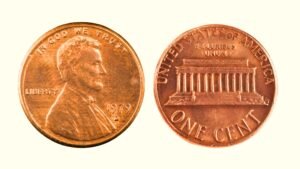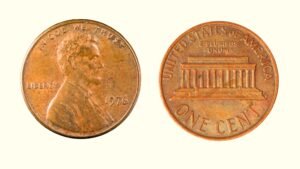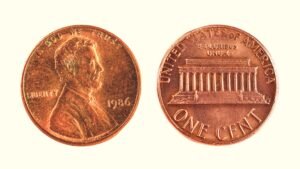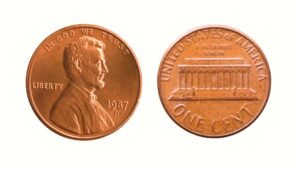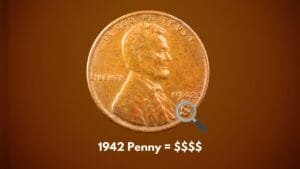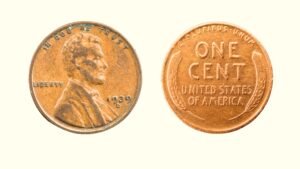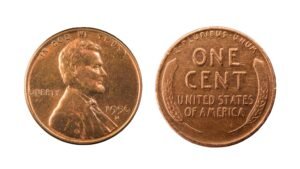Do you have an old 1935 Lincoln Wheat Penny in your coin collection or are you planning to sell or buy one? If yes, you’re at the right place!
In this detailed price guide, I’m going to tell you about all the valuable features you must look for on your 1935 Wheat penny that could make it worth as much as a whopping $55,000 today!
From its history to its rare features, like mint marks and unique minting errors and varieties, learn how to find the most valuable 1935 Lincoln wheat cent now!

Interesting History of 1935 Lincoln Wheat Cent
The 1935 Lincoln Wheat Penny is a significant part of the series, first introduced in 1909 to commemorate President Abraham Lincoln’s centennial birth year! It was designed by Victor David Brenner, featuring Linconl’s bust on the front and wheat years on the back!
By 1935, the Lincoln Cent had become a valuable coin among Americans as well as the government as it played a crucial role during the Great Depression. The year 1935 saw substantial penny production across all three operational mints – Philadelphia, Denver, and San Francisco.
These pennies were particularly important during this period as even a single cent held significant purchasing power. Many everyday items, from candy to newspapers, could be bought for just a penny, making these coins essential to daily commerce in 1935 America.
| 1935 Lincoln Penny | Key Features |
| Coin Composition | Bronze (95% Copper, 5% Tin & Zinc) |
| Minting Location | Philadelphia, Denver & San Francisco |
| Year of Minting | 1935 |
| Face Value | One-cent |
| Weight | 3.11 grams |
| Diameter | 19.05 mm |
| Thickness | 1.52 mm |
| Designer | Victor David Brenner |
| Mint Marks | No Mint Mark (Philadelphia Mint) D-mint mark (Denver Mint) S-mint mark (San Francisco Mint) |
| Total Mintage | 331,090,000 |
Identifying a 1935 Lincoln Cent (Design & Physical Features)
Spotting a real 1935 Lincoln Wheat Penny requires you to pay attention to details that authenticate it. From the distinct designs on the front and back to the materials used, here’s what to look for:
1935 Lincoln Penny Obverse:

- A bust profile of Abraham Lincoln facing right
- The words “IN GOD, WE TRUST” on the top
- “LIBERTY” on Lincoln’s left
- The mint date “1935” to the Lincoln’s right (slightly lower)
- The mint mark “S” or “D” (if present) below the mint year
- Fine details in Lincoln’s bow tie and coat lapel serve as authentication points
1935 Lincoln Penny Reverse:

- The denomination “ONE CENT” at the top-center
- Words “UNITED STATES OF AMERICA” written right below the denomination
- Two wheat ears/stalks framing “ONE CENT” and “UNITED STATES OF AMERICA”
- “E. PLURIBUS UNUM” written on the top, along the edge
1935 Lincoln Cent Composition, Weight & Size
The 1935 Lincoln Wheat Penny follows the standard specifications established for the series with a composition of 95% copper and 5% tin and zinc, giving them their characteristic reddish-brown color. Each penny weighs precisely 3.11 grams and measures 19.05 millimeters in diameter with a thickness of 1.55 millimeters.
The coin’s edge is plain (smooth) rather than reeded, a characteristic that helps distinguish it from other denominations. Verifying these details is also crucial to spot counterfeits.
Finding a 1935 Lincoln Penny Value (3 Key Factors)
In circulated, average condition, a 1935 Lincoln penny is worth anywhere from 3 to 10 cents. But depending on different factors, such as mint marks, overall condition and color, and rare errors, the value can increase up to a few thousand dollars!
1. Coin Grading, Condition, and Color Designation
The first and most important factor to impact a 1935 penny value is its condition. The coin’s condition is evaluated by grading using a numerical scale from 1 to 70, where high grades mean better condition.
Based on the numerical grades, you can value your 1935 wheat penny as follows: Poor (P-1) to AU (50-58) are typically valued at $0.25 to $5. Mint State (MS-60 to MS-65) grades can fetch $8 to $60, and Gem Mint State (MS-67 and above) examples can range from $150 to as much as $50,000 or more!

Within these grades, color designations also play a vital role in determining a coin’s value, particularly for uncirculated examples. The three recognized color categories are:
- Red (RD): The most valuable designation, Red pennies retain at least 95% of their original red mint luster. Red 1935 pennies in MS-67 or better can command premiums of $200 to $10,000 or more, as they’re the most desirable to collectors.
- Red-Brown (RB): These coins have 5% to 95% of their original red color with mix toning. The values for RB 1935 pennies range from $30 to $200 in uncirculated grades.
- Brown (BN): Having completely toned to a brown color through oxidation, these coins are still collectible but generally command the lowest premiums, ranging from $10 to $20 in uncirculated grades.
2. Mint Marks & Mintage
| Coin Grades | 1935 No Mint Mark Penny Value | 1935 D Penny Value | 1935 S Penny Value |
| Poor (0) to Extremely Fine (XF45) | 25 cents to 50 cents | 30 cents to 80 cents | $1 – $3 |
| Almost Uncirculated (AU50) to Mint State (MS60) | 80 cents to $3 | $1 to $3 | $3 – $10 |
| Mint State (MS61 – MS64) | $8 – $20 | $10 – $25 | $15 – $55 |
| Mint State (MS65 – MS66+) | $20 – $50 | $30 – $130+ | $50 – $1,200 |
| Mint State (MS67 – MS67+) | $140 – $600 | $200 – $3,100+ | $1,350 – $6,000+ |
| Mint State (MS68 or Above) | $3,700 – $55,800+ | N/A | N/A |
The 1935 Lincoln Wheat Penny was minted at three different facilities: Philadelphia (no mint mark), Denver (D), and San Francisco (S). The unique mintage and mint mark from each facility directly impacts your penny’s rarity and worth!
1935 No Mint Mark Penny Value (Mintage – 245,388,000)
The Philadelphia Mint was the powerhouse of penny production in 1935, producing over 245 million pennies in 1935, identified with no mint mark. In circulated conditions, a 1935 no-mint mark penny typically trades for $0.25 to $2.
However, uncirculated examples can command significant premiums, with MS63 to MS64 Red examples valued at $12-25 and MS65 to MS66+ reaching $20 to $75. MS67 and MS67+ coins fetch $150-650 and superb MS68 and MS68+ RD pieces potentially reach $4,000 to $55,000!
The most expensive 1935 No Mint Mark penny was an MS68 Red example that was bought for an auction record price of $55,813 on Legend Rare Coin Auctions!
1935 D Lincoln Penny Value (Mintage – 47,000,000)
The Denver Mint’s 47 million 1935 Lincoln cents are identified by the “D” mint mark beneath the date. Denver-minted pennies are generally well-struck overall, often displaying sharper details than their Philadelphia counterparts, and hence, slightly more valuable, too!
A 1935 D penny typically commands a slight premium over Philadelphia issues, with circulated examples worth $0.50-$3.
Uncirculated Denver cents are particularly desirable, with MS65 Red specimens valued at $25-$60, MS66 and MS66+ Red examples bringing $50-$140, and the rare MS67 and MS67+ Red pieces commanding $200 to $4,000, like this MS67+ example sold for $4,080 on Stack’s & Bowers!
1935 S Lincoln Penny Value (Mintage – 38,702,000)
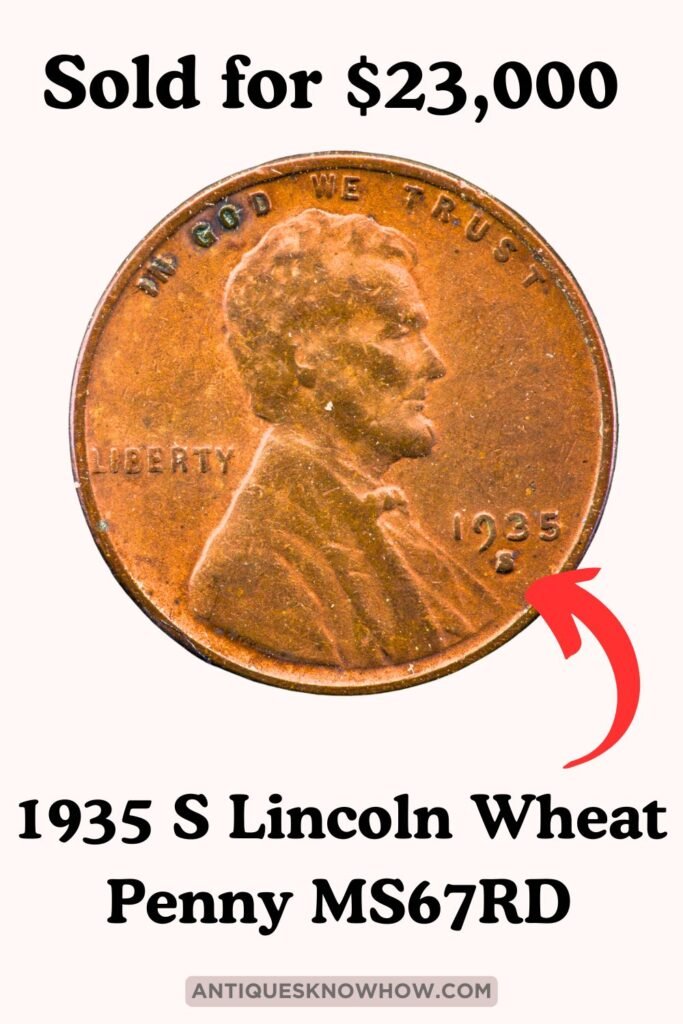
The San Francisco Mint, denoted by the “S” mint mark, had the lowest production of the three facilities in 1935, striking over 38.7 million pennies. This makes high-grade San Francisco cents particularly valuable today.
Circulated 1935 S penny examples range from $1-$5, while uncirculated pieces in MS64 to MS65 Red grades typically bring $30-$120. MS-66 and MS-66+ Red examples can fetch $250-$1,000, and the rarest MS67 examples can fetch $1,350 to $6,000!
The highest value for a 1935-S penny was released at Bowers & Merena Auctions where it sold for $23,000 in MS67 grade, as per PCGS!
3. Most Valuable 1935 Lincoln Penny Errors
Some of the most valuable 1935 Lincoln Wheat Pennies are those with rare minting errors. These can significantly increase the coin’s worth. Here are some of the key errors to watch for:
Cud Die Break
Cud Die Break errors when a portion of the die breaks away during the minting process, resulting in a distinctive raised blob or irregular mass of metal on the coin’s surface. The value of this 1935 penny error varies with the size and location of the cud.
The average value ranges from $10 to $50 in circulated conditions, like this Fine Grade F-15 example sold for over $35 in a coin auction. Mint condition 1935 Lincoln cents with dramatic cud die error can fetch $50-$500 or more!
Broadstruck Error
Broadstruck errors occur when coins are struck without the restraining collar that normally forms the rim with the specific diameter. You can spot these 1935 penny error coins by their larger size, smaller thickness, and no defined rim.
Circulated examples of 1935 1C Broadstruck Lincoln penny typically bring $20-$50, while uncirculated examples can fetch $50-$300 or more. For instance, this MS6R Red and Brown example sold for over $105 at Heritage Auctions!
Off-center Strike Error
Off-Center Strike errors result from misalignment between the planchet and dies during striking. The degree of off-centeredness greatly affects value, with slight misalignments of 5-10% bringing modest premiums of $25-$130. More dramatic examples showing 20-30% off-center strikes can command $200-$400.
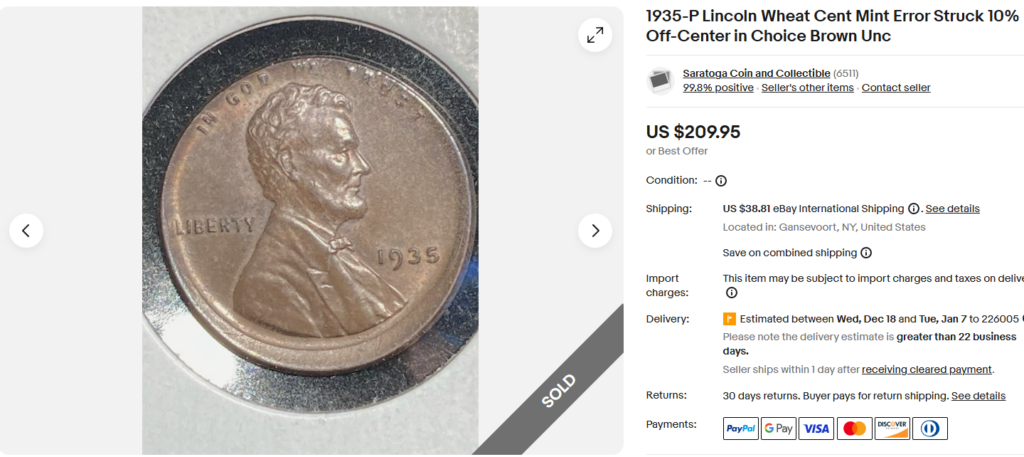
This 1935-D MS60 Brown example with 30% off-center sold for almost $265 while this MS64BN example with only 5% off-center sold for $126 on Heritage Auctions!
Die Adjustment Strike
Die Adjustment Strikes are created when mint workers test die spacing and pressure using minimal striking force, resulting in coins with incomplete design transfers and shallow relief. In 1935 Lincoln pennies, die adjustment strikes typically display weakly impressed design elements, often with a ghost-like appearance.
An NGC-graded 1935 Wheat Penny with visible Die Adjustment Strike sold for almost $205 on Heritage Auctions in 2023!
In addition to these, look for the common Doubled Die errors, curved clip errors, struck-through errors, and rare wrong planchet errors on your 1935 Lincoln Cent. These rare coins can be worth big bucks, too!
So, where you’re selling or buying an old 1935 Lincoln wheat penny, make sure to identify all the rare features using this guide before trading it!
Note: This article is intended for informational, educational, and entertainment purposes only. Some images are illustrative and may not represent actual brands, products, or related entities. All trademarks, product names, brand logos, packaging, and other intellectual property referenced remain the exclusive property of their respective owners. Any brand mentions or references are provided solely for descriptive and educational context and do not imply any formal or commercial association.


